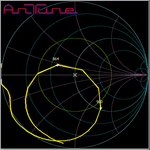E Kafeman
Advanced Member level 2
I have evaluated box size and other parameters for a few years now and compared result with well calibrated multi-reverberation/anechoic chambers, literally world around, with aid of helpful RF-labs.
Result is most accurate when size of box is limited relative wave-length but more important is that box is regular in size and that its walls are clean and non RF absorbing.
It is easy to check if a box is usable by measuring a simple dipole for a wide freq-range. Say antenna for 2.4GHz can be measured 500 MHz-4 GHz or what range box is intended to be used for.
The biggest problem is if a box creates a standing wave distance between two walls which causes a frequency specific dip in measured antenna impedance.
This is checked by software and a popup message is telling about it if a such problem is identified but it can also for a simple antenna structure be identified as irregular frequency behavior that not belongs to antenna.
As can be seen in my video is the box used noting but reflecting walls but they are not causing any big problems as long as software can identify and correct for them.
As with other measurement methods are there a lot to say and know. A good start is to measure simple dipole antennas with well known performance or previous measured by two or three antenna method.
I create my own simple dipole antennas using CU-tape. Quartewave sleeves to block reflections along measurement cable (not ferrit!). A such antenna can easily be designed to have an efficiency above 95-98% at center-freq and have a very wide frequency range where it behaves without any impedance surprises.
Efficiency drops outside of center freq. but it does in in a very predictable way without any hick-ups which makes it easy to check if a box seems usable.
As it often is, is previous RF measurement skills and experience are important factors to do reliable and repeatable measurements and that is so also for this method.
Repeated efficiency measurement result is for me typical within in 0.2 dB with this method. That is a precision seldom reached in a anechoic chamber or multi reverberation chamber.
To reach that precision must details be taken in account such as that added cable length in chamber also must be added in free space measurement part.
Additional info about this method can be read at https://www.antune.net/wheeler and there are also links to other papers.
Result is most accurate when size of box is limited relative wave-length but more important is that box is regular in size and that its walls are clean and non RF absorbing.
It is easy to check if a box is usable by measuring a simple dipole for a wide freq-range. Say antenna for 2.4GHz can be measured 500 MHz-4 GHz or what range box is intended to be used for.
The biggest problem is if a box creates a standing wave distance between two walls which causes a frequency specific dip in measured antenna impedance.
This is checked by software and a popup message is telling about it if a such problem is identified but it can also for a simple antenna structure be identified as irregular frequency behavior that not belongs to antenna.
As can be seen in my video is the box used noting but reflecting walls but they are not causing any big problems as long as software can identify and correct for them.
As with other measurement methods are there a lot to say and know. A good start is to measure simple dipole antennas with well known performance or previous measured by two or three antenna method.
I create my own simple dipole antennas using CU-tape. Quartewave sleeves to block reflections along measurement cable (not ferrit!). A such antenna can easily be designed to have an efficiency above 95-98% at center-freq and have a very wide frequency range where it behaves without any impedance surprises.
Efficiency drops outside of center freq. but it does in in a very predictable way without any hick-ups which makes it easy to check if a box seems usable.
As it often is, is previous RF measurement skills and experience are important factors to do reliable and repeatable measurements and that is so also for this method.
Repeated efficiency measurement result is for me typical within in 0.2 dB with this method. That is a precision seldom reached in a anechoic chamber or multi reverberation chamber.
To reach that precision must details be taken in account such as that added cable length in chamber also must be added in free space measurement part.
Additional info about this method can be read at https://www.antune.net/wheeler and there are also links to other papers.



